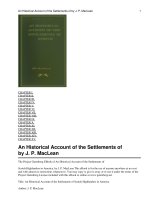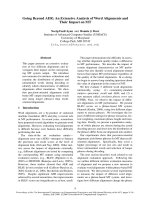Bailout an insiders account of bank failures and rescues
Bạn đang xem bản rút gọn của tài liệu. Xem và tải ngay bản đầy đủ của tài liệu tại đây (5.22 MB, 316 trang )
IRVINE H. SP&\GmJ
An Insider~s Account
of Ban]{ Fallores
a,nd Rescues
.... '~- ~
/Y
;
..: .' ....:
'
ISBN 0-465-00577-2
> $17-95
"Irv Sprague's book is a classic ."-FERNAND J.
ST GERMAIN , Chairman, The Committee on
Banking , Finance and Urban Affairs , U.S.
House of Representatives
BillOIJT
IRVINE H. SPRilGUE
Recently this country has experienced more
bank failures than at any time since the Great
Depression. While hundreds of banks have been
allowed to go under, four were considered
"essential" and were bailed out by the government. Why these four and not all the others?
This unprecedented insider's account tells the
full story of those dramatic rescues-from the
initial reluctant decision to step in, to the final
implementation of a bailout plan in a politically
charged atmosphere . As Chairman and Director
of the FDIC, Irvine Sprague handled far more
bank failures than anyone else in U.S . history
and was directly involved in crafting these four
bailouts. His first -hand account takes us behind
closed doors to show how decisions were made
at the highest levels . And he describes the
behavior under stress of the participants in these
high stakes dramas: the regulators, such as
Federal Reserve Chairman Paul Volker; high
figures in the Administration, such as the then
Treasury Secretary Donald Regan; and managers of the nation's leading banks . The story
culminates with the controversial1984 bailout of
the $41 billion Continental Illinois Bank, which
Sprague helped engineer.
(continued on back flap)
0986
BAILOUT
BAILOUT
An Insider's
Account
of Bank Failures
and Rescues
IRVINE H. SPRAGUE
Basic Books, Inc., Publishers
NEW YORK
Ubrary of Congress Cataloging-in-Publication Data
Sprague, Irvine H.
Bailout: an insider's account of bank failures and
rescues.
Bibliographic notes: p. 271.
Includes index.
1. Bank failures-United States. 2. Banks and
banking-Government guaranty of deposits. 3. Federal
Deposit Insurance Corporation. I. Title.
HG2491.S67 1986
332.1'2'0973
85-73883
ISBN 0-465-00577-2
Copyright @ 1986 by Basic Books, Inc.
Printed in the United States of America
Designed by Vincent Torre
86 87 88 89 90 HC 9 8 7 6 s 4 3 2 1
To Terry and Junie
They would have enjoyed this project
more than anyone else
CONTENTS
ix
PREFACE
PART ONE
The Stage Is Set
Chapter I I Bailout
The Thesis Is Introduced
3
Chapter II I The Legal Framework
The Law and the Regulators Who Interpret If
12
PART TWO
The First Three Bailouts
Chapter m I Unity Bank
The Essentiality Doctrine Is Established
35
Chapter IV I Bank of the Commonwealth
The First Bailout of a Billion-Dollar Bank
53
Chapter V I First Pennsylvania Bank
The Prototype Is Created for Megabank Bailouts
77
PART THREE
Two Potential Bailouts That Never Happened
Chapter VI I Penn Square
A Small Oklahoma City Bank Tri11ers a Crisis
109
Contents
viii
Chapter VII I Seafirst
The Firs/ Major Casually from Penn Square
135
PART FOUR
Continental
Chapter VIII I Seven Days in May
Continental Is Saved from Certain Failure
Chapter IX I May to July
Search for Continental Solution Is Underway
149
Chapter X I The Treasury Tiger
Treasury Complicates lhe Rescue
182
Chapter XI I Choosing the Management
The Swearingen-Ogden Team Is Selecled
200
Chapter XII I liquidation
The Fed, lhe Board, and lhe Bad Loans
213
165
PART FIVE
Where Do We Go From Here?
Chapter XIII I Lessons Learned
History Does Tell Us Something
231
Chapter XIV I The Public Policy Debate
Serious Questions Are Raised About Bailouts
242
APPENDIX
265
NOTES
271
INDEX
281
PREFACE
FOUR PERSONS met behind closed doors for a few hours in
the spring of 1984; they decided to do the largest government
bailout in American history-the rescue of Continental Dlinois
Bank. At the time I thought how different this was from the
fishbowl atmosphere at the White House and in Congress
where I had participated in less far-reaching decisions. This
story is told solely from my perspective; I did not seek advice
on whether to proceed from the other three participants-Paul
Volcker, Bill Isaac, or Todd Conover.
As I began sifting through my files in preparation for retirement, I decided to write this book to document for the first time
how decisions that have enormous impact on the public are
made by the bank regulators. Although secrecy is essential at
the time of the transactions, it cannot be justified after the fact.
After the decision to write was made, I chose to chronicle the
evolution of the essentiality doctrine, which derives from the
statutory authority for bank bailouts. Initiated with the rescue
of tiny Unity Bank in 1971, the doctrine was developed, expanded, and refined in two subsequent bailouts. Thirteen years
later it was used to save giant Continental Dlinois. Within this
framework, I discuss and describe all of the options considered
in every bank failure, large and small. I speak with authority,
particularly concerning the rescues. No other principal participated in more than two of the long-term commercial bank
bailouts in FDIC history. I worked and voted on all four.
During the latter stages of the Continental crisis, at a particularly frustrating time in the negotiations, I felt the public should
know not only the nature of our enormous undertaking, but the
X
Preface
conflict of personalities and opinions among the negotiators
that made our task unnecessarily difficult. Oftentimes during
our deliberations, we debated points that I thought had been
decided earlier. I realized that I was subconsciously recalling
earlier bailout battles in which I had participated.
Continental was not merely a peak-it was a link in a chain
that we had been forging since the 1971 rescue of Unity Bank.
Other bailouts, of successively larger institutions, followed in
ensuing years; there is no reason to think that the chain has
been completed yet. Indeed, new links in this less-than-illustrious progression can form with frightening speed, as experience
has demonstrated.
Early in my career the mission of the Federal Deposit Insurance Corporation (FDIC) was to do such a good job protecting
depositors that they did not have to know anything about a
bank except that it was FDIC-insured. That symbol of confidence on the door means just that. I was proud that the agency
to which I devoted a good portion of my working life achieved
its objective to a remarkable degree.
Then a new element came into play: the abrupt and steep
increase in bank failures in the 1980s. More Americans than
ever before were suddenly becoming aware of the presence of
FDIC and its handling of bank failures. We were no longer some
abstract federal guarantee. Our people were on the scene week
in and out, taking over failed banks and taking care of insured
depositors. Uninsured depositors, investors, management,
stockholders, and delinquent borrowers got another view of
FDIC in action. It was very much at our discretion whether and
when any person with more than $100,000 in a failed bank
would receive any part of it. Delinquent borrowers suddenly
found out that they were being pressed for collection. Directors
of former banks found themselves sued for damages for neglecting prudent operation of their banks.
Most of all there was a hue and cry over the reality of different treatment between megabanks and small banks. Nowhere
Preface
was this more apparent than in the Continental case when we
announced in May 1984 that everyone who had money in the
multibillion-dollar institution would be fully protected, regardless of the amount of insurance coverage. The resulting uproar
echoed from one end of the country to the other; it rang in the
halls of Congress. Particularly vehement were those newly educated the hard way-those people who had lost uninsured
money in small-or medium-sized banks that we had handled
without 100 percent protection for all depositors and investors.
We were accused of discrimination in favor of large banks in
the press, in Congress, and on the scene.
Suddenly the bailout question assumed a vast new relevance.
Not only was it a good story, an unknown story, that should
be told; it had become important to show that we really had
explored all the other options before going to the last resortbailout. (Although I am now gone from the FDIC, I somewhat
automatically interchange the words "we" and "FDIC"
throughout the book.) Therefore, my purpose is to illuminate
what happened and why it happened. I hope to help a new
generation of regulators and bankers learn from the lessons of
the past. Even more importantly I hope this book will help raise
public awareness of the pitfalls that can keep them from realizing the opportunities of the exotic new financial world of the
1980s.
Although I had long mulled over the idea of this book, my
wife, Margery, finally launched this project. I gratefully acknowledge this debt among many others to her. I would not
have committed myself to it without her quiet but effective
urging, which no doubt stemmed from her desire to find a
constructive outlet for the restless energy of a husband entering
retirement after nearly thirty active, often hectic, years in public service. l-and perhaps she, too-owe a special thanks to
Martin Kessler, my editor and publisher, who first encouraged
me to write the book and then was unrelenting in criticism that
made the final product better. I wish here to also acknowledge
xii
Preface
the many persons, within FDIC and without, who shared their
recollections and observations with me and verified facts. To
each I am indebted. They are too numerous to list individually,
but I would like to single out for special mention Alan R. Miller,
my top assistant during the first three bailouts; Todd Conover,
who generously jogged his memory for recollections of dates,
incidents, and conversations; Frank Wille for his memories of
how the two of us initiated use of the essentiality doctrine; Stan
Silverberg, Mike Hovan, Mark Laverick, Peter Kravitz, and
Roger Watson, who shared with me their recollections; Margery, who excised my split infinitives and made numerous other
suggestions regarding grammar and punctuation; Sabrina
Soares for her patient, friendly editorial assistance; and for his
advice and assistance, Kenneth Fulton.
PART ONE
The Stage Is Set
Chapter I
Bailout
The Thesis Is Introduced
BAILOUT is a bad word. To many it carries connotations of
preference and privilege and violation of the free market
principle. It sounds almost un-American.
Nevertheless, in recent years our government has participated in eight notorious bailouts. Four were commercial
banks declared to be essential and saved by the Federal Deposit
Insurance Corporation (FDIC). The other four were assistance
transactions for public and private entities enacted by Congress.
This is the story of the four bank bailouts, told in the context
of turmoil in the financial arena, a fast-moving deregulatory
scene, and increasing concern over the unfairness of the special
handling now given to failing larger banks.
Banks are failing in record numbers and will continue to do
so for the foreseeable future. The combined 200 failures in 1984
and 1985 exceeded the forty-year total from the beginning of
World War II to the onset of the 1980s. It is time to rethink our
policies and procedures. The routine solutions of the past no
longer suffice.
4
THE STAGE
Is
SET
Megabanks approaching bankruptcy today are given preferred treatment that is denied the smaller banks throughout
the nation. This disparity will come into clear focus as the
bailouts are discussed.
When bank failures were a rarity it really didn't matter. But
today, with the probability of a continuing failure rate exceeding one hundred banks a year, the time is long past when we
can ignore the fairness issue.
By focusing on the four bailouts we have a ready framework
in which to describe the ways all bank failures are handled, the
complex regulatory structure that hampers the effort, the conflicts that arise in stressful situations, and the options for improvement of the process.
The four congressionally approved bailouts were for Chrysler
Corporation, Lockheed Corporation, New York City, and Conrail. One, Lockheed Corporation, was approved by a single
vote. Each was preceded by extensive public debate.
The four commercial banks declared essential and then
saved with long-term FDIC assistance were: the $11.4-million
Unity Bank and Trust Company of Boston in 1971, the $1.5billion Bank of the Commonwealth of Detroit in 1972, the
$9.1-billion First Pennsylvania Bank of Philadelphia in 1980,
and finally the $41-billion Continental Illinois National Bank
and Trust Co. of Chicago in 1984. * All were handled behind
closed doors. Penn Square Bank and Seattle First National
Bank are also discussed because of their relationship to the
bailouts, as are the liquidation procedures used after a bank is
either closed or bailed out.
Unity posed a unique problem at a time the nation was
wracked by race riots. When Commonwealth, First Pennsylvania, and finally Continental faced the FDIC board, each
would have been the largest bank failure in history.
The cost of the bank bailouts far exceeded the congressio-
•sank asset size is shown here at the peak shortly before failure. All had
shrunk somewhat by bailout day.
Bailout
5
nally approved ones. The contrast between the publicly discussed congressional bailouts and the behind-the-scenes bank
rescues by FDIC has generated a debate that seems destined to
continue so long as we have megabanks in the nation that might
fail.
Chairman Femand St Germain of the House Banking Committee set the focus in House remarks on July 26, 1984, as he
called for hearings a few hours after we announced the Continental bailout:
The rescue of Continental dwarfs the combined guarantees
and outlays of the Federal Government in the Lockheed,
Chrysler and New York City bailouts which originated in this
Committee. More important is the fact that the Federal Government provided assistance to these entities only after the
fullest debate, great gnashing of teeth, the imposition of tough
conditions, and ultimately a majority vote of the House and
the Senate and the signature of the President of the United
States. 1
The goals of this book are multiple and related as we dissect
FDIC's four long-term "essential" commercial bank bailouts
and describe the process, the procedures, the conflicts, and the
solutions.
1. We will remove the element of mystery and provide an insight
as to exactly how bank failures are approached by the regulators, what options are considered, when officials cooperate, and
when they resort to confrontation.
2. We will analyze the successes and the failures of the four bank
bailouts, describe how the banks got into trouble, and provide
a play-by-play account of how the bailouts were accomplished,
giving the details of the transactions.
3. We will discuss the public policy question of whether the nation
is better or worse off when bank bailouts are consummated.
And we will suggest whether or not there will be more.
4. We will provide conclusions as to what changes should be made
in terms of attitude, law, or regulation.
6
THE STAGE
Is
SET
This is, of necessity, a personal story since much of what will
be told is not on the public record or any record at all in many
instances. It is based primarily on my recollections and personal
papers. This is not the product of a researcher or reporter attempting to piece together what may have happened. It is not
the thesis of a professor opining &om remote academia about
what should have happened. It is an insider's account of what
really did happen. It addresses many questions:
What does the law say? How did the process work? Who
made the key decisions? What alternatives were considered?
What was the interplay between the bank regulatory agencies
and the administration? How did the U.S. Treasury hamper and
nearly derail the Continental rescue? What was the behavior of
the chiefs of the nation's largest banks? Should the multinational giant banks like Continental continue to enjoy de facio 100
percent insurance at bargain basement rates while their smaller
brothers have only limited protection?
In short, why and how were four institutions selected to be
saved, and only these four? What do these experiences imply
for the years ahead? Are bank bailouts a footnote in history, or
the wave of the future? Those readers who stay with me will
find the answers to all of these questions, and more.
Why am I the one to tell this story? Because I was the only
one who was there through all four bailouts. From beginning
to end I was involved as either the chairman, or director, as a
participant in endless discussions, arguments, meetings, and
ultimately the decisions. No other board member was involved
with more than two. I worked on the Unity and Commonwealth cases during my first term; after a six-year absence I
returned to participate in the handling of First Pennsylvania
and Continental. In the first three I provided the decision to
proceed for a divided board. The board was unanimous about
Continental from the beginning.
A number of other FDIC directors, of course, were deeply
involved, making crucial contributions along the way, particu-
Bailout
7
larly Frank Wille and Bill Isaac while each was chairman. But
none of them benefited from the continuity of working on all
four cases.
Who were the people making these far-reaching decisions,
subject to no higher review? 2 Bill Camp, from Texas, had been
a long-time career bank examiner; Frank Wille and John Heimann had served as New York bank superintendents; Bill Isaac
had been a Kentucky bank lawyer; Todd Conover came from
a California consulting firm; and Tom DeShazo, a career bank
examiner from Virginia, often voted for Comptroller Camp at
our board meetings.
Like all the other board members, I had no hands-on experience running a bank. What I brought to the position was a deep
insight on how government really works, refined and developed
over twenty-nine years in Washington. I served as special assistant to President Lyndon Johnson in the White House, deputy director of finance for California Governor Edmund G.
"Pat" Brown, executive director of the House Steering and Policy Committee for Speaker Thomas P. ''Tip" O'Neill, and director of the House Whip office for Congressman John McFall.
Wille, Isaac, and Conover are Republicans; Camp, Heimann
and myself Democrats; politics, however, played no role in our
decisions. FDIC directors are political persons in the sense that
the law itself establishes the political participation of the board.
The Federal Deposit Insurance (FDI) Act provides that not more
than two of the three directors shall be of the same political
party. The board elects its chairman, normally to match the
party of the president. After that, politics ceases. FDIC is independent in fact as well as on the organizational charts. All
directors soon find that the need for safety and soundness of the
banking system rises above politics. This is not necessarily true
in other agencies of government, such as the U.S. Treasury;
these agencies are clearly linked to, and ultimately controlled
by, the White House.
Appointed through the political process from widely diver-
8
Ta1
STAGE
Is
SET
gent backgrounds, FDIC board members nonetheless shared
many common attributes. All were underpaid, overworked,
dedicated, and honest. One was brilliant. One treasured anonymity; one had an insatiable need for personal publicity. All
have my respect and friendship.
Washington, D.C., is the ultimate revolving door as people
come and go because of ambition, ineptitude, or the changing
tides of political fortune. Over the years, many others appeared
on the scene while I served on nine different FDIC boards. I
served eleven and one-half years-longer than any member
since Leo Crowley in the earliest days of the corporation. I
observed a wide variety of talents, attitudes, ability, and responses as crises came and went. From this experience I can
predict with some confidence generally how any future FDIC
board and the other regulators will behave, regardless of who
holds the responsibility.
Over the years, I worked with four Federal Reserve chairmen
-William McChesney Martin, Jr.; Arthur F. Burns; G. William
Miller; and Paul Volcker. Six comptrollers of the currency and
nine treasury secretaries overlapped my terms.
From its beginning on January 1, 1934, through April3, 1986,
when I retired, FDIC assisted 908 failed or failing banks. I
participated in handling 374, or 42 percent of the fifty-two-year
total. In terms of dollar volume of assets I worked on 92 percent.
The Continental bailout is the most recent, the biggest, the
most controversial, and the most interesting. I will recount its
story last because to understand Continental you need to know
the experience we gained and lessons learned in the three previous bailouts. These first crises enabled us to craft the Continental package under enormous pressures with some assurance that
what we were doing would work. I will describe the evolution
of this thought process in detail in the chapters on the first three
11
essential" bailouts.
The essentiality doctrine also has been used in two other
bank cases not relevant to this account. 3 One bank was deemed
Bailout
9
"essential" for less than three weeks; the other was a stateowned institution, and the state was considered essential.
The apprenticeship we served in the earlier cases provided me
with confidence as we tackled the biggest problem of all. Every
single lesson we had learned from previous decisions, good and
bad, was incorporated in one way or another into the Continental solution.
The learning years with Unity, Commonwealth, and First
Pennsylvania were relatively tranquil. Our board was divided,
but never publicly. True, we faced and won a stockholder suit
over the warrants in First Pennsylvania, but none of these first
three bailouts generated more than nominal public notice.
There were minimal congressional hearings. The land was
quiet.
Then came Continental.
It was the biggest banking story since President Franklin D.
Roosevelt's banking holiday in 1933 and the press played it as
such. Serious questions were raised as we grappled for a solution, recurred after the announcement of what we had done,
and continue to this day.
Those of us who made the decision were convinced we had
no other choice. The Continental rescue, which made available
roughly $15.3 billion from several sources, • dwarfed the other
seven FDIC and congressional bailouts, which totaled about $6
billion in loan guarantees and grants.
Many believe FDIC should save all failing banks, a concept
that is clearly beyond the law. But still, the real world is sometimes hard to accept. The recurring question is, "Why did you
save Continental and not my bank?" This is the question I will
address.
The following basic changes in the law, technology, and psy•The Continental use of the rescue package peaked at $13.7 billion on
August 13, 1984: $7.6 billion in Fed borrowings, including $3.5 billion later
assumed by the FDIC; $4.1 billion in safety net borrowings from other banks;
and $2 billion in capital notes from the FDIC and the banks, later reduced to
$1 billion from the FDIC. The continuing FDIC investment thus is $4.5 billion.
10
THE STAGE
Is
SET
chology since we embarked on the essentiality trail more than
fifteen years ago will certainly color any future decisions.
1. The laws have been amended to permit the interstate sale of a
large failed bank.
Our technology has been improved and staffing enhanced so the
direct payoff of a bank of many billions of dollars is now entirely feasible.
3. The psychology has changed-the public expects bank failures
and accepts even big ones. In 1968, my first year on the FDIC
board, there were just three small failures all year; on May 27,
1983 we handled six failures in one day and in November of
1985 there were seven failures over a weekend.
2.
What were the real reasons for doing the four bailouts? Simply put, we were afraid not to.
Would an FDIC board be more courageous, or foolhardy,
now to allow the collapse of a multinational giant? This question highlights the inequities that abound throughout the system and continue to grow. What we should do about them will
be addressed as the bailout stories lead us to a series of inevitable conclusions.
The idea of writing this book came to me as I went through
my personal records in preparation for retirement, bundling
some to be sent to the National Archives in Washington, D.C.,
others to the Lyndon B. Johnson Presidential library in Austin,
Texas, and the proposed Jimmy Carter Presidential Library in
Atlanta, Georgia.
The exercise focused my attention on the fact that I have a
unique perspective gained over a long period of years about
how banks are regulated and how failures are handled. All this
would be lost if not chronicled now. The stories I tell are based
on official records, hearings, and reports that are available to the
public, plus personal files and memories, buttressed by postmortem conversations with other participants.
In talking with other past and present regulators, I was en-
Bailout
11
couraged by most to proceed. The time has long since passed
when this information might be sensitive, yet it holds historical
interest and will be helpful in providing an understanding of
the process and in formulating future policy. Other insiders
have their own perspective and certainly would tell the story
differently, but the basic facts are unchallenged.









